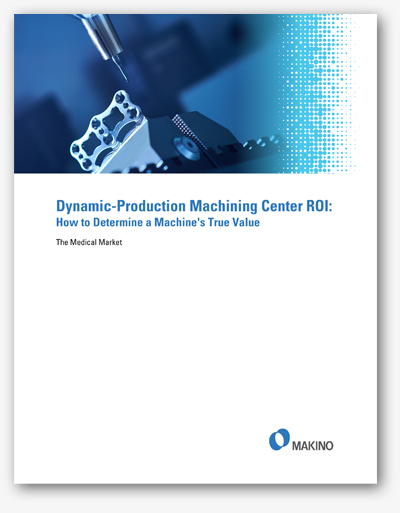
To be competitive today, medical parts manufacturers must leverage the most advanced technology while keeping a pulse on maximizing long-term reliability, accuracy, and ROI. With many low-cost solutions available, it’s important to calculate a machine’s true ROI before making a purchase.
While low-cost solutions are appealing because of the price, investing in high-performance machining centers can ultimately facilitate a better, more profitable solution for your business. Oftentimes an ROI analysis only focuses on equipment price; however, there are a number of features you should examine in depth in order to determine a machine’s true value. Some factors include:
- Life cycle cost
- Acquisition costs—leasing vs buying
- How operating costs affect productivity
- Short-term vs long-term maintenance costs
- Decommission costs
- Hidden costs of ownership
- Features of dynamic-production machines
- How automation can improve ROI
- Various types of leases and how they impact ROI
An additional factor you should incorporate into the ROI analysis is 5-Axis machining capabilities. Transitioning from a 3+2 setup to a true 5-Axis setup can yield impressive results for ROI. This is because a 5-Axis process reduces setup and part-handling time, enables you to machine more accurate parts, and result in streamlined operations. It also provides medical manufacturers the ability to produce small- to medium-sized parts using a highly productive spindle. Even more impressive, 5-Axis machining gives allows you to produce multiple parts on one run—improving part continuity and reducing cycle time. These capabilities of true 5-Axis production can result in process optimization and significantly improve ROI.
Purchasing a low-cost solution can have severe and long-term consequences on ROI. It can cost businesses more in terms of higher part costs, shorter tool life, increased scrap, unplanned downtime, and higher maintenance costs. When factoring in how unplanned downtime can eat into the ROI, it’s important to consider machine features that help minimize unexpected production interruption. Selecting features like this may increase your upfront expense; however, they can save manufacturers from unnecessary delays and higher overhead—protecting your uptime and investment.
How you choose to finance the machine can affect long-term cost of ownership as well. Liquidity risk, monthly cash flow margins, lower operating costs, and asset depreciation all should be factored into the ROI equation. In fact, depending on the financing solution you choose, the low-cost machine may be anything but economical. Even though the high-performance may have a higher initial cost, you’ll typically achieve greater ROI than with the “low-cost” machines.
It’s why you should thoroughly examine your business and the impact that a low-cost versus high-performance machine will have on your bottom line in order to make a fully informed choice.
In this revolutionary whitepaper, you’ll discover all essential costs and factors to include when calculating ROI. Traditionally, these often-overlooked aspects may not be top of mind; however, they are extremely important to the larger picture of long-term profitability and productivity for your company.
>>Download the White Paper>>

 To be competitive today, medical parts manufacturers must leverage the most advanced technology while keeping a pulse on maximizing long-term reliability, accuracy, and ROI. With many low-cost solutions available, it’s important to calculate a machine’s true ROI before making a purchase.
To be competitive today, medical parts manufacturers must leverage the most advanced technology while keeping a pulse on maximizing long-term reliability, accuracy, and ROI. With many low-cost solutions available, it’s important to calculate a machine’s true ROI before making a purchase.